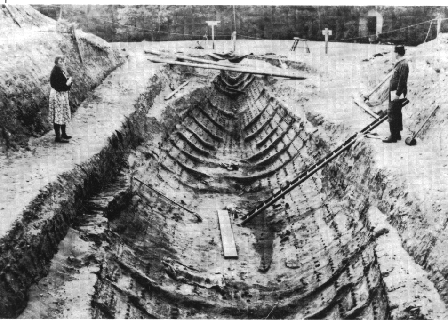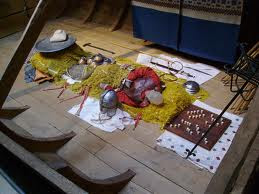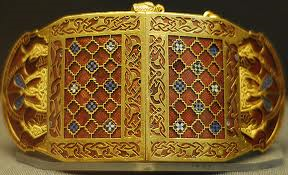Mrs Edith Pretty lived in the village of Sutton Hoo, overlooking the River Deben and the town of Woodbridge in Suffolk. She believed that there were important ancient burial mounds on her property. In 1938 she asked an archaeologist to excavate the barrows. Three of the mounds had been robbed in ancient times but one still contained a spectacular Anglo Saxon burial chamber built inside a 30 metre long wooden ship.
 | |  Inside the burial mound was the imprint of a decayed ship and a central chamber filled with unfathomable treasures. It is the richest intact early medieval grave ever found in Europe. More than a grave, it was a spectacular funerary monument. The Sutton Hoo Treasure is one of the most important finds in British history. Inside the burial mound was the imprint of a decayed ship and a central chamber filled with unfathomable treasures. It is the richest intact early medieval grave ever found in Europe. More than a grave, it was a spectacular funerary monument. The Sutton Hoo Treasure is one of the most important finds in British history. |
 | The treasure included armour, weapons, gold coins, gold jewellery with garnet settings, silver cups and silver-supported drinking horns, a leather purse with a jewelled cover containing 37 gold Merovingian coins, three coin-sized blanks and two ingots.
 |  |
 | The burial chamber was probably constructed for an East Anglian monarch (bretwalda) - likely King Rædwald.
 |  |
 | The site has been vital to historians for insight into the Anglo-Saxon Kingdom of East Anglia and the early Anglo-Saxon period in the 6th century. |  |
  | The gold belt buckle is a masterpiece of early medieval craftsmanship, made using over 400g of gold with an intricate decoration of intertwining creatures inlaid with niello (a black metal alloy).
A purse lid would have been attached to a leather pouch which originally hung from a waist-belt. Frankish gold coins were found inside. Only the gold frame and catch survived, the leather pouch had decayed away. Gold coins and ingots were found inside the purse. Each coin came from a different mint in Francia, across the English Channel, and they provide key evidence for the date of the burial. Analysis of their gold content and date of minting point towards the period around AD 610–635. Gold coins and ingots were found inside the purse. Each coin came from a different mint in Francia, across the English Channel, and they provide key evidence for the date of the burial. Analysis of their gold content and date of minting point towards the period around AD 610–635. |
 | The shield had a metal rim and gilded copper alloy and gold and garnet fittings. It is the most elaborate shield to survive from Anglo-Saxon England. The original board, made from lime wood covered in animal hide, perished and has been replaced with a modern replica. The true identity of the grave's inhabitant may never be certain. When it was unearthed, any bodily remains had long since been claimed by the acidic soil leaving only a human-shaped gap among the treasures.  |
















No comments:
Post a Comment